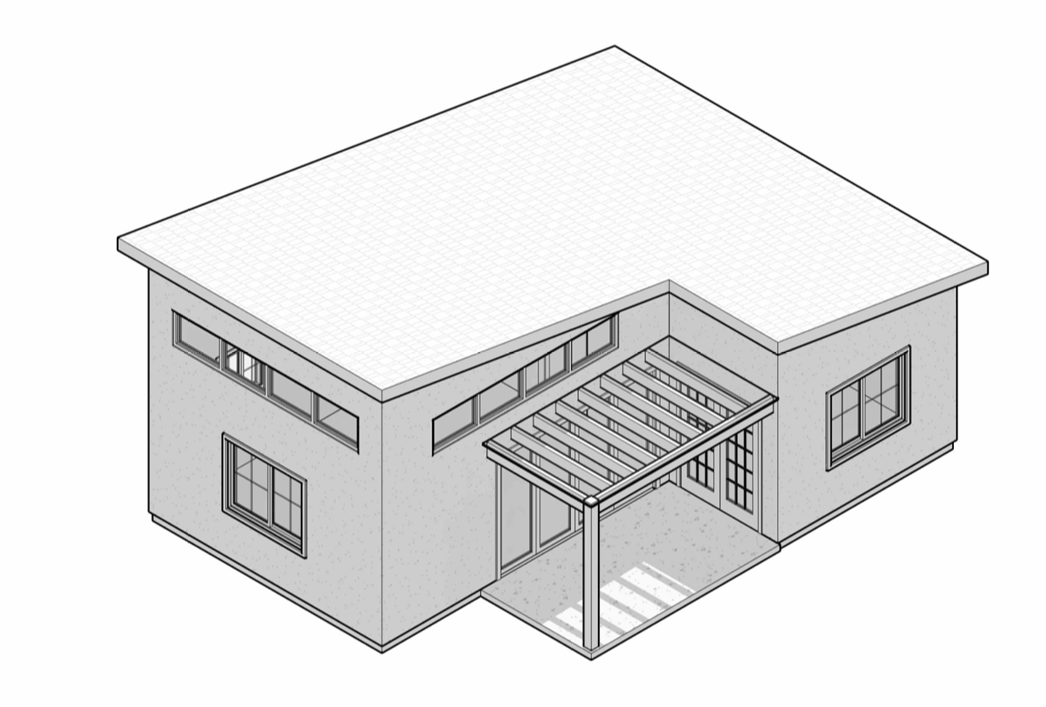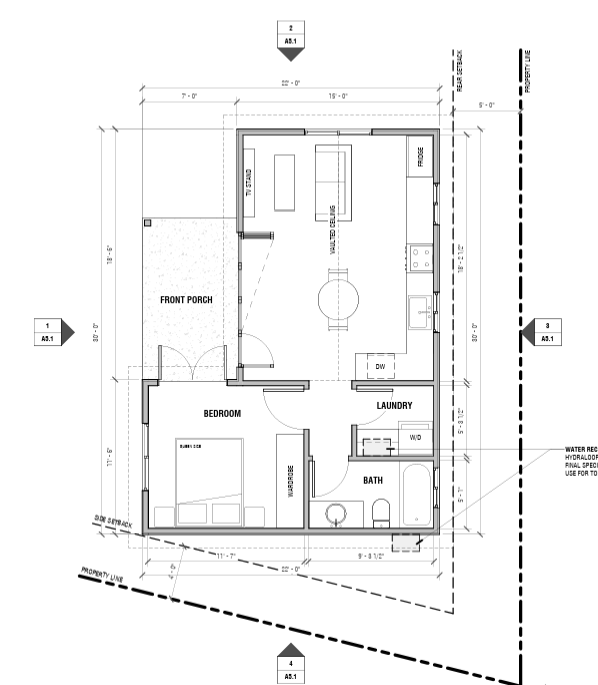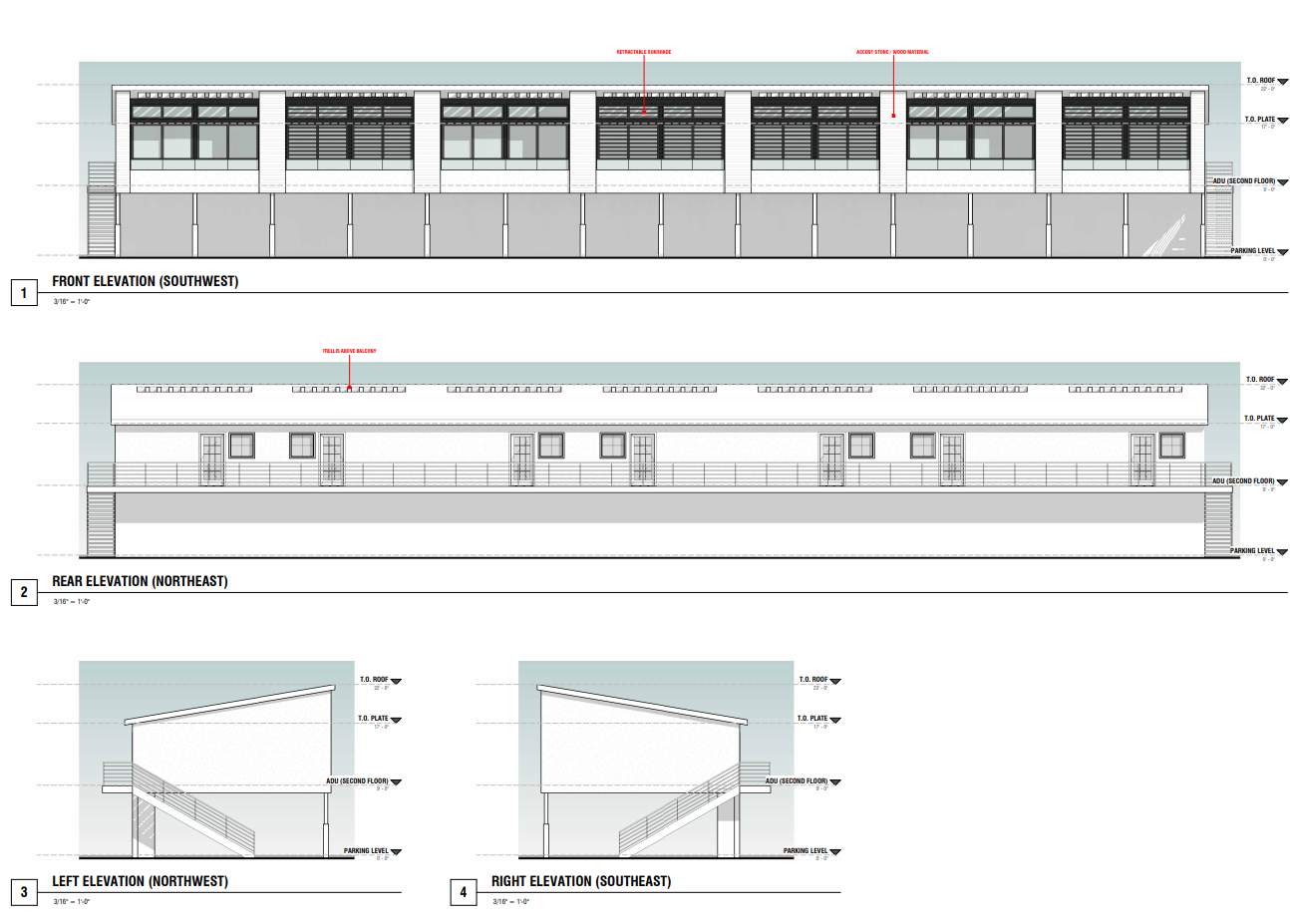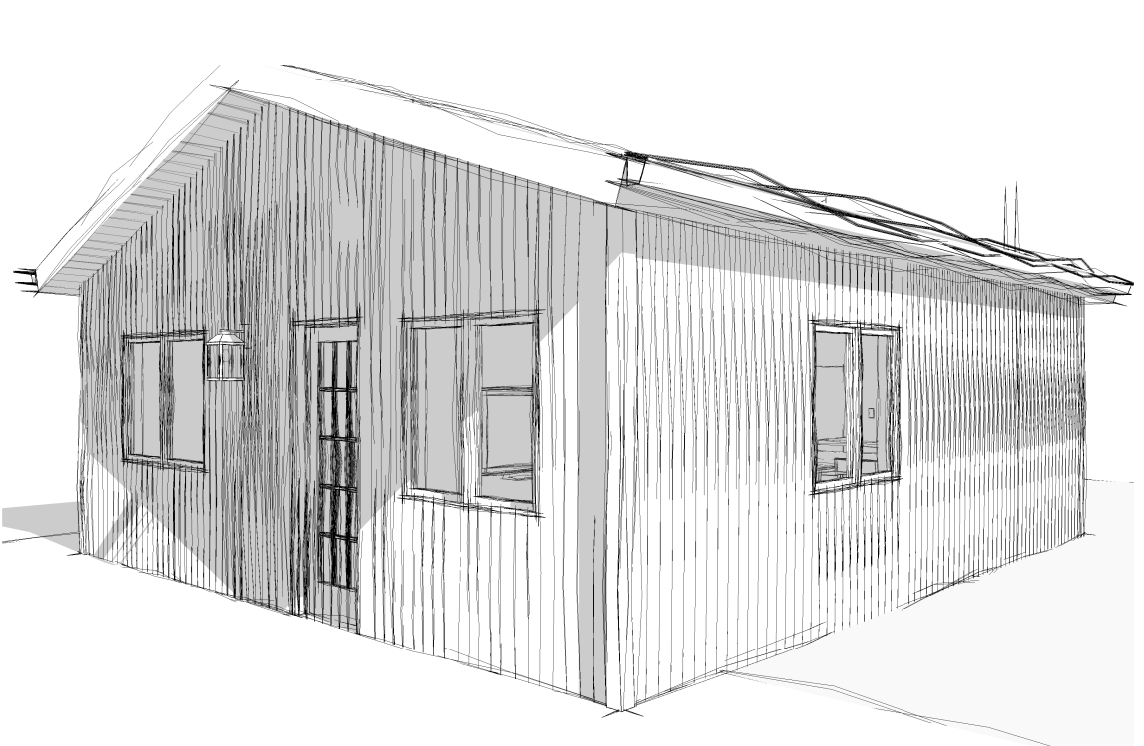
Project Overview
A small infill lot in the Irvington neighborhood is getting a new accessory dwelling unit. The owner chose an off-site–built, steel-framed modular box to speed up delivery and cut waste.
Project Details
A small infill lot in the Irvington neighborhood is getting a new accessory dwelling unit. The owner chose an off-site–built, steel-framed modular box to speed up delivery and cut waste. The module arrives with walls, roof, wiring, and rough plumbing already complete; crews only need to bolt it to a stem-wall slab, hook up the utilities, and finish the cladding. The brief is clear: one bedroom, one bathroom, full kitchen, vaulted ceiling, clerestory windows, and large fold-away doors that spill onto a patio under a pergola.
Design snapshot
The module is an “L” shape about 450 sq ft inside. A seven-foot-deep covered porch sits in the crook of the L and doubles as weather protection for the entry. Once inside, a single room holds living, dining, and kitchen functions. The kitchen runs the long exterior wall and ships with factory-installed quartz counters, soft-close cabinets, an induction range, and an 18-inch dishwasher. Opposite the cooktop, a six-foot island seats two; when the foldable doors open, that island feels connected to the patio so indoor meals can flow outdoors in seconds.

A pocket door leads to a compact bedroom sized for a queen bed and two built-ins. The adjacent bath uses a five-foot tub/shower combo and wall-hung vanity to save floor space. A stacked washer-dryer hides in its own niche between bath and kitchen. Every interior finish—paint, flooring, trim—goes on in the factory so site time stays short.
Envelope and daylight
A mono-slope roof pitches to the rear, creating a vault that tops out at 11 feet above the living room and slopes to 9 feet at the bedroom. Just below the high roof line, a continuous band of clerestory windows brings daylight deep into the plan while preserving privacy from the side yard. The steel frame accepts 2 × 6 light-gage studs filled with mineral-wool insulation, achieving R-23 walls and an R-38 insulated roof cassette. Exterior cladding is fiber-cement panel with a light sand-float texture; flashings and window trim come in a charcoal powder-coat to resist Fremont’s sea-air corrosion.
Mechanical + water
Cooling and heating rely on a ductless 12-k BTU mini-split mounted high on the living-room wall; the outdoor condenser sits on a pad behind a privacy screen of dwarf bamboo. Domestic hot water comes from a 40-gallon heat-pump electric heater located in the laundry niche. Under-sink canisters deliver three-stage filtration—sediment, carbon, and RO membrane—so both kitchen and bath basins pour purified water without separate countertop units.
Outdoor room
Because Fremont enjoys mild evenings, outdoor living space got equal weight in the program. A site-built pergola with steel posts aligns to the module’s eaves, creating a 10-by-12 patio that feels like an extension of the interior. A simple paver field covers the ground; creeping thyme fills the gaps for a soft, barefoot-ready surface. Low-water shrubs—California fuchsia, dwarf manzanita, and silver carpet—edge the hardscape and keep irrigation demands low. A cedar slat fence frames the courtyard and supports climbing jasmine for seasonal fragrance.
Numbers that matter
- Architect + engineering fees: $12,000 flat, covering modular shop drawings, California-licensed structural review, Title 24, and permit support.
- Construction + finish allowance: $350 per sq ft. That figure includes factory labor, on-site set, crane pick, slab, utilities, interior finishes, appliances, pergola, and landscaping.
- Permit path: Fremont treats detached ADUs under 800 sq ft as ministerial. No public hearing, no design review board, and impact fees are waived for the first 750 sq ft. Submittal scope is architectural set, structural calcs, compliance docs, and PV pre-wire affidavit (solar is required only if total site solar is absent).
Assembly sequence
- Factory build (6 weeks). Module leaves the line with electrical rough-in, plumbing stubs, insulation, drywall, primer, cabinets, and windows installed.
- Site prep (parallel 3 weeks). Local crew pours 18-inch stem-wall slab, trenches 20 feet for sewer tie-in, and runs 1-inch water line from street meter.
- Delivery + set (1 day). A 120-ton crane swings the unit onto the slab, steel plates are welded to embedded straps, and the crew seals the marriage line under the roof plane.
- Hook-ups + finishes (2 weeks). Electric, water, and sewer connections finalize; siding panels, roof membrane, and pergola kit complete the exterior.
- Landscape install (1 week). Drip lines, plants, pavers, and a final blower clean finish the job.
Why steel modular here?
- Speed. Fremont’s rain-lite but permit-heavy climate rewards anything that slashes on-site time. Two months from slab to keys is realistic.
- Strength. Light-gage steel resists termites and won’t twist as it dries—key in a seismic zone that can’t afford soft-story drift.
- Precision. Factory-built walls arrive square, plumb, and dimensionally accurate, easing Title 24 air-leakage targets at inspection.
- Sustainability. Steel framing is 100 % recyclable. The unit’s heat-pump systems and all-electric appliances future-proof it against gas-ban ordinances.
Takeaways for other Bay Area lots
A detached ADU doesn’t need exotic materials or mega budgets to feel special. Start with smart daylighting (clerestories), full-height glazing you can actually open (folding doors), and durable, low-maintenance shells (steel + fiber-cement). Keep systems simple—ductless HVAC, heat-pump water heater, water filtration—so future service calls are rare. Budget clarity matters most: know your all-in cost target—$350 /sq ft in this case—and build every decision around staying inside that envelope.
The Fremont project shows how a modest backyard can host a modern, resilient home without disrupting the neighborhood fabric. One truck-delivered module, a crane pick, two weeks of finish work, and the city gains a new dwelling—ready for parents, renters, or anyone needing a foot in the Bay Area’s housing market.
Our Approach
Discovery & Planning
We analyzed the property, zoning regulations, and homeowner goals to create a customized feasibility plan.
Design
Our designers created custom floor plans maximizing space while respecting the budget and aesthetic preferences.
Permitting
We navigated city requirements and handled all paperwork, securing permits efficiently.
Construction
Our licensed contractors brought the ADU to life with premium materials and meticulous attention to detail.
Ready to Build Your Dream ADU?
Let's discuss how we can help you create additional living space, generate rental income, or provide housing for loved ones.


